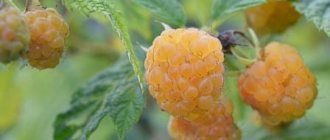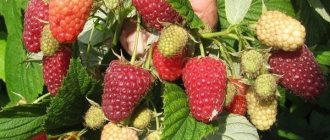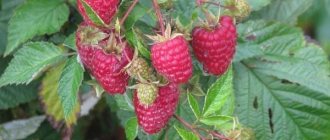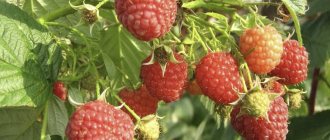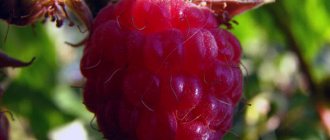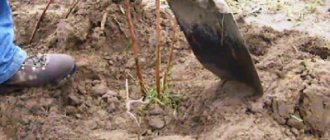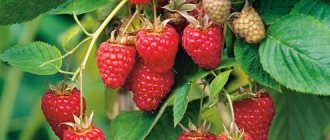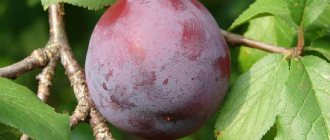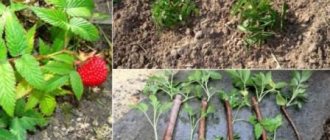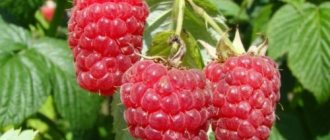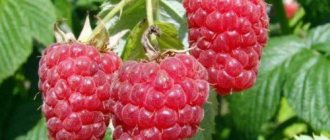Description of raspberries of the Eurasia variety
The large-fruited remontant variety belongs to standard raspberries and is characterized by an early harvest. This is a universal variety that can consistently bear fruit when grown in different conditions, without making special demands on soil and climate. Raspberry Eurasia is resistant to most diseases and pests of garden plants.
Remontant large-fruited raspberries were bred by breeders I.V. Kazakov and S.N. Evdokimenko. and Kulagina V.L. in 1994. It is distinguished by its early ripening.
Remontability of raspberries is the ability to bear fruit not only on 2-year-old shoots, but also on one-year-old shoots, which significantly extends the period of fruiting. Eurasia is a standard, upright growing bush, reaching a height of 1.3–1.6 m. Usually 5–6 replacement shoots are formed on it; the shoots do not grow very actively.
When ripe, the raspberry bush is strewn with berries
One-year-old shoots are thick, covered with thorns and a thick waxy coating. There is also slight pubescence. By the end of the growing season they acquire a purple color. Two-year-old stems are straight and brown in color. The thorns are of medium length, curved down, planted quite sparsely, concentrated mainly near the base of the stem. The lateral branches, which are fruiting wood, have a strong waxy coating and weak pubescence.
Standard bushes, with large, slightly wrinkled leaves
Large green leaves with a wrinkled surface have a very peculiar, slightly twisted shape and lacy arrangement. In general, the bush looks quite original and is often used for garden decoration. Raspberries bloom in the second half of July and ripen in August. Large (average weight 4–4.2 g) and dense berries have a conical shape and are colored dark crimson, the surface of the skin is matte.
The berries are very large in size
The pulp tastes sweet and sour, non-aromatic. The berries are rich in vitamin C - 34.9 mg per 100 g, and contain little sugar - 7.1%. The drupes in the fruits are firmly linked to each other. The separation of berries from the fruit is good.
Raspberry Eurasia on video
Characteristics of the variety
A description of the remontant raspberry Eurasia will not be complete without considering a number of other characteristic features.
Drought resistance, frost resistance
The raspberry bush of the Eurasia variety is resistant to drought, but at the same time the heat resistance indicators are very low. These concepts are completely different:
- Drought resistance - the shrub can go without watering for a long time, which will not lead to a loss of taste and a decrease in yield.
- Heat resistance - elevated temperatures and low air humidity reduce the ability to develop and bear fruit.
The frost resistance of the Eurasia raspberry tree is quite high. Thanks to this quality, the variety has gained the greatest popularity among gardeners in the Siberian regions.
The originators of the variety announced a technology for autumn mowing of shoots before wintering, but judging by the reviews of Siberians, the Eurasia raspberry variety is able to overwinter without pruning. Temperatures up to -30 °C, with proper preparation and timely shelter, are not critical for the shrub.
Productivity and fruiting
Fruit harvesting on Eurasia raspberry bushes can begin in early August of the first year of planting. Different sources, as well as reviews from gardeners, indicate different characteristics of fruiting - some claim that the berry is early ripening, others that it is a mid-ripening variety. The berries are easily separated from the stalk, but even a week after full ripening, they are resistant to shedding and rotting.
The Eurasia raspberry tastes sweet with a pronounced sourness, due to the high content of ascorbic acid in it (up to 35%), and does not have a pronounced aroma. The tasting events carried out allow us to give Eurasia raspberries 4 points out of 5.
One raspberry tree bush can produce about 1.5 kg of ripe fruit. The high productivity of the Eurasia variety can fluctuate up or down, depending on factors:
- climatic region;
- growing conditions;
- agrotechnical practices.
Important! Intensive agrotechnical cultivation methods will allow you to collect an impressive harvest of finished products - up to 5.5 kg of raspberry drupes from one bush in 60 days.
Area of application of fruits
Raspberries of the Eurasia variety can be consumed and stored not only fresh and processed, but also frozen. The dense consistency of the drupe allows it to retain its shape and structure after defrosting, which will not lead to spreading and the appearance of a homogeneous jelly mass.
The density of raspberry fruits allows the product to be transported over long distances without changing or compromising its integrity.
This raspberry variety can also be enjoyed by long-term storage:
- without additional cooling at room temperature, the berry can last up to 72 hours;
- when stored refrigerated (refrigerator, basement), the berry retains its structure and freshness for 7 days.
Resistance to diseases and pests
Raspberry Eurasia is not 100% resistant to diseases and pest attacks. But, with the help of appropriate medications, the problems that arise can be dealt with without the risk of crop loss and death of the bush.
Advantages and disadvantages of the variety
Test cultivations and reviews from gardeners have identified both positive characteristics and some disadvantages in the Eurasia raspberry variety.
The advantages of the bush include:
- Productivity.
- Long-term storage and transportation.
- Berry size.
- Drought resistance.
- Resistance to shedding.
- Possibility of growing in any climate zone.
- Possibility of mechanized cleaning.
- Decorative look.
- No increased care requirements.
Eurasia raspberries do not have any shortcomings as such, but they can be summed up by the ongoing debate among gardeners about the taste of the berries. For some farming enthusiasts, this factor is a disadvantage, and for others, it is a piquant highlight.
Advantages and disadvantages
Advantages:
- large size and good presentation of berries;
- early ripening;
- high yield (2.2–2.6 kg per bush);
- unpretentiousness to soil and climatic conditions (for example, in the unfavorable conditions of the Leningrad region, Eurasia still produces 1.3–1.6 kg of berries);
- high drought resistance.
Flaws:
- low sweetness of berries.
- average resistance to pests and diseases.
Raspberry tree Eurasia
Eurasia is a representative of remontant varieties, that is, producing 2 harvests per year. The first can be collected in mid-summer, and the second - closer to autumn. The variety is characterized by early ripening and tasty large-fruited berries.
Registration of Eurasia in the State Register of the Russian Federation was carried out in 2008 after appropriate variety trials. The seeds themselves were first obtained back in 1994 by a team of breeders from the All-Russian Selection and Technological Institute of Horticulture and Nursery Growing. Various remontant varieties from Europe and Asia were involved in the crossing. Perhaps thanks to this diversity, breeders named the new variety Eurasia.
Appearance of the bush, characteristics of the berries, fruiting dates
Eurasia is a universal variety and is perfect for fresh consumption, as well as preparing preparations for the winter: compotes, juices, preserves and jams.
Like all remontant varieties, Eurasia has a number of typical characteristics:
- Fruiting begins on shoots of the first year of growth, but can also occur on two-year-old shoots.
- The bush is considered medium-sized.
- The height of the shoots does not exceed 1.4 m - this means that it is not necessary to tie up the bushes and install a trellis. Shoots are not formed too abundantly - no more than 7 pcs. at one root.
- The stems of the first year are green, up to 3 mm thick in diameter. By autumn the shoots darken. In the second year, they become lignified and acquire a light brown bark. The shoots are characterized by slight pubescence.
- Eurasian plantings are not thickened, and this is convenient for caring for plants.
- Fruiting occurs on small lateral branches. Raspberry leaves are a standard green color, quite large, with a wrinkled leaf blade.
- The variety is characterized by high drought resistance, average resistance to heat, frost and disease.
- Resistance to pests in remontant varieties is due to the fact that they begin to bear fruit later than the classical varieties, to which the life cycle of the main pests is adapted. Therefore, by the time the ovaries form on remontant varieties, the pest development cycle has already been completed, and there is simply no one to attack the plantation.
- Medium-sized flowers have slight pubescence. 5 weeks after flowering, conical berries form on the bushes.
- The color of the fruit is uniform, dark crimson. The sweet and sour pulp with a classic raspberry taste does not have a pronounced aroma. The sugar content does not exceed 7.1% and this is the average sugar content. The tasting rating of the variety is rated as 3.9 out of 5 possible points.
- The yield of the variety is not too high - only 2.6 kg per bush, while the average for the same varieties is 4-5 kg per bush. The yield declared by the producers on the site is 130–140 c/ha.
Video: Remontant raspberry variety Eurasia
Advantages and disadvantages of the variety
- Eurasia has all the main advantages of remontant varieties:
- fruiting begins already in the first year after planting;
- good resistance to frost and drought;
- no need to cover shoots for the winter;
- possibility of growing in regions with short summers;
- high resistance to diseases and pests;
- ease of care;
- possibility of harvesting 2 times per season;
- The variety has large, dense, transportable berries with good taste.
- Disadvantages of the variety:
- the taste qualities of Eurasia are not too high; tasting score of the variety - only 3.9 points;
- The yield cannot be called high, rather it is average.
Landing Features
Landing dates
Raspberries are planted during the dormant period. It is usually recommended to plant in the spring so that the plants are well rooted and strong before winter.
Selection of planting material
When purchasing raspberry seedlings, there is a risk of getting plants infected with viral diseases. Therefore, it is best to take planting material from a state nursery. Carefully inspect the selected seedlings. Their quality is determined by a well-developed root system, without dried or rotten areas, and healthy, undamaged stems.
You can obtain planting material yourself by dividing the bushes growing on the site. During the pruning period, remove excess healthy shoots with a fork, grabbing as many roots as possible.
Healthy root shoots can be used for planting
Raspberries can also be propagated by seeds. Collect a certain amount of ripe berries in a nylon bag, crush the pulp and rinse under running water. Dry the seeds directly with the bag and put them in the refrigerator. At a temperature of +1...+3 degrees they will remain viable for several years. Replanted seeds usually retain their remontant properties.
Selecting a location
Raspberries prefer slightly acidic soil that can hold water well. At the same time, plants do not tolerate even a short-term oversaturation of the soil with moisture; it has a detrimental effect on the root system. So when planting on soils prone to stagnant moisture, you need to ensure good drainage.
Raspberries can be grown on dry semi-sandy and sandy soil, as well as on low-fertility calcareous soil, if good watering and a regular supply of organic fertilizers are provided.
For raspberry bushes, protection from wind, which damages shoots and disrupts the activity of pollinating insects, is extremely important. Planting in the shade of trees should not be done - fruiting is sharply reduced and the berries become sour. Plants develop optimally in well-lit areas (especially in cold regions), but slight shading is also allowed.
Soil preparation
You need to prepare the soil for planting in advance, in the fall. First of all, remove all the weeds and dig grooves 3 shovels wide and 1 bayonet deep for each raspberry row. Compost or rotted manure (layer 8–10 cm) is placed at the bottom of the groove and mixed with the soil with a pitchfork. After this, the ditch is covered with earth and complex fertilizer is applied.
Long before planting, you should prepare the planting groove and add fertilizer to it.
If the area is heavily turfed, 2-tier digging will be used. Turf, buried in the soil, acts as a fertilizer, so additional organic matter does not need to be added.
Landing
When planting raspberries in several rows, orient them in a north-south direction so that they do not shade each other. A distance of 1.5–2 m should be maintained between rows, and 0.5 m between bushes in the same row.
You can plant in holes 35–38 cm wide and 25–30 cm deep. In small areas, it is convenient to plant plants in groups of 1–3 at a distance of 50–70 cm from each other.
When planting raspberries, be sure to leave the root collar at soil level.
Landing sequence:
- Place the seedlings in the prepared grooves. The depth of the seedling should be no more than 7–8 cm. The root collar should remain at the level of the ground surface or (for light soils!) it can be buried by 3–5 cm.
- Carefully straighten the roots. Fill the ditch with soil and compact it. It is better to do this with your hands so as not to damage the seedlings.
- Cut the stem at a height of 25–30 cm from the soil surface, leaving a growth bud.
- Water the plantings.
Planting berries on video
Reviews
Most reviews are devoted to the taste of fruits or yield, but I would like to write about an aspect that I have never seen in comments. My review is about survival. Of course, it’s good when the berries are large, sweet and there are a lot of them, but first of all it is necessary for the seedling to take root. But I just couldn’t achieve this. I planted seedlings several times, seemingly with a developed root system, seemingly according to all the canons, but the result was always the same - out of 10 pieces. Only 2-3 survived. I don’t know what I did wrong, maybe the seedlings themselves (I bought them delivered by mail) were already dry, I don’t know, it’s hard to judge. However, I also bought Eurasia with mail delivery and all of the 6 seedlings were accepted. And there were no differences in the planting of Eurasia from other varieties that never took root. So think about it, guess what’s the matter. Therefore, I can recommend the variety to people who want to get results with a high degree of probability. Otherwise, you know, seedlings are expensive, you, excuse me, you can say, you blow them in the ass, but there is no result.
I don’t like this variety, it has no flavor, so I make jam from it. There are a lot of berries growing, the variety is productive, so as I do, I use the Daughter of Hercules variety for food. But for conservation it’s Eurasia.
The Eurasia raspberry variety has many advantages, but gardeners are still arguing about its taste. These discussions are purely subjective. High yields, large fruits and ease of care more than compensate for this drawback. Maybe it is for this reason that Eurasia is quite popular.
Features of care
Top dressing
Regular fertilizing guarantees high yields. It is recommended to apply potassium sulfate (30–35 g/m2) to raspberries every autumn, and ammonium sulfate (15 g/m2) every spring. Superphosphate (60 g/m2) is added every 3 years. Nutrients are scattered in dry form, covering the soil surface 45–50 cm around each bush. To penetrate the minerals into the soil, water immediately after application and then mulch the soil with organic fertilizers (raw peat, manure, 5 cm layer). The stems should remain clean.
Tying up
Eurasia raspberry bushes are quite stable and maintain a vertical position; they don’t need to be tied up. But if desired, to facilitate processing of bushes and harvesting, you can tie raspberry bushes to trellises, which can be made single-row or double-row. The simplest support option is a single-row trellis. For it, poles 2–2.5 m high are driven along a row and wire is pulled over them in 2–3 levels.
A single-row trellis is the simplest and most convenient support for raspberries.
Trimming
Every spring, remontant raspberries form new shoots, which produce a harvest the same year, after which the fruiting tip of the shoot dries out. It should be trimmed. The remaining part of the shoot will produce a harvest the following year. So Eurasia raspberries can produce crops simultaneously on 2- and 1-year-old shoots; the fruiting period is very extended. You just have to keep in mind that getting double harvests leads to a decrease in overall yield and loss of berry quality. Therefore, experts recommend growing remontant raspberries as an annual crop, completely cutting off the annual shoots that bear fruit for the winter. Such care allows you to successfully combat pests and diseases, and also solves the problem of winter hardiness.
Pruning remontant raspberries on video
Raspberry Eurasia is not prone to intensive formation of root shoots. Nevertheless, it is advisable to immediately prune all emerging shoots with a sharpened shovel at a depth of 5–8 cm. This stimulates the formation of replacement shoots for the next year.
Soil care
The soil around the bushes should be kept loose and free from weeds. Regularly destroy weeds with shallow loosening. Be careful not to damage the raspberry roots: they are located at a depth of 15–20 cm.
Watering
Due to their shallow roots, raspberries are sensitive to soil drying out. The Eurasia variety has sufficient drought resistance, but it is still better to provide the plants with moisture regularly, mainly in dry weather. Raspberries are usually watered 6-7 times per season. Water for the first time when replacement shoots begin to sprout (usually in the last ten days of May), at the rate of 2 buckets per 1 meter of row.
Raspberries can be watered by sprinkling
In June - July, water at regular intervals 4 more times. In August, it is advisable not to water at all, unless there is intense and dry heat. By the end of September, moisture-recharging irrigation is carried out.
Preparing for winter
If you choose the method of annual mowing of the stems, then you don’t have to worry about preparing for winter. If you decide not to cut the stems, you should tie the young shoots in bunches, bend them to the ground and cover them with nutrasil, reeds, spruce branches or other insulating materials.
Selection of seedlings
It is advisable to buy seedlings from a gardening nursery with a good reputation. You can also resort to the help of a large specialized online store. As a rule, they cooperate with specialized organizations and sell high-quality planting material, monitoring varietal purity.
Criteria for choosing a seedling:
- Planting material should be selected with a root system 20 cm long and with 3–4 buds at the base of the stem.
- The thickness of the shoot should not be less than 1 cm.
You should not pay attention to the length of the shoot, since it will still have to be trimmed before planting. But you should not purchase too large and lush seedlings, because they do not take root well in a new place.
More on the topic: Hayes nectar raspberry
Before planting, you need to remove all leaves from the plant and cut off the ground part to a level of 30 cm. If there are dried areas on the roots, they should be removed. Then the seedling is placed in water for 6–8 hours so that it is saturated with moisture. If the plant was purchased long before planting, it should be buried.
Raspberry diseases and pests and their control
Table: raspberry diseases and methods of their treatment
| Name of the disease | Manifestation of the disease | Treatment methods |
| Purple spot | The appearance of purple-brown spots at the attachment points of leaves. Then necrotic spots appear on the leaves and fruit branches, leading to drying out. | Follow the rules of agricultural technology, monitor the ventilation of plantings and prevent excess humidity. Cut out infected stems, including the area below the soil surface. Spraying at the beginning of bud break with 1% Bordeaux mixture. In summer, use a solution of copper oxychloride (30–40 g per bucket of water). Treat three times: when young shoots grow to a size of 15–20 cm, before flowering and immediately after flowering. |
| Gray rot | The fungus affects leaves, buds, stalks, shoots and berries. The edges of the leaves and berries are covered with a gray, fluffy-looking coating. In wet weather, you can lose up to half the harvest. | Spray the bushes and the soil around them with HOM (30–40 g per 10 liters of water) before the leaves bloom. Pollination by ash during the formation of ovaries. Avoid sprinkling irrigation. |
| Raspberry chlorosis | Yellowing of the leaves is observed. The disease can be of two types - viral and physiological. With the viral form, the leaves not only turn yellow, but also become deformed and become smaller. The growth of shoots slows down, the berries turn out dry and “wooden”. Spread by aphid larvae. Physiological chlorosis occurs due to a deficiency of certain microelements and unfavorable weather and soil conditions. | To prevent viral chlorosis, control aphids using insecticides. Plants affected by the virus are cut out and destroyed. To treat physiological chlorosis, find out its cause. If the disease is associated with increased soil acidity, add ground gypsum (100–120 g/m2). If chlorosis is caused by high humidity, reduce watering and provide drainage. For prevention, apply humus, compost, forest litter (every 2–3 years 5–6 kg/m²) to the fertilized area. During watering, add an infusion of bird droppings diluted 1:10 to the water. |
Raspberry diseases in the photo
Berries affected by gray rot become inedible
Purple spot often affects raspberries late in the growing season.
Chlorosis can be spread by aphid larvae
Table: raspberry pests and their control
| Pest name | Manifestation of the disease | Fighting methods |
| Raspberry bud moth | Pests are dark brown butterflies. Their larvae look like red caterpillars with a dark brown head. The caterpillars overwinter in the soil, and in the spring they climb the raspberry stems and eat the buds, and subsequently damage the berry fruit. | Comply with agrotechnical requirements. If possible, cut off shoots for the winter. During the period of bud swelling, use insecticides (Karbofos 0.3% or Decis). |
| Spider mite | A sucking pest of small size (0.3 - 0.5 mm), orange-yellow in spring and greenish-yellow in summer. Settles on the lower surface of leaves, entwining them with cobwebs. Damaged areas are highlighted with light dots, then with discolored areas. Darkening and drying of the leaves are observed. | Collect and burn fallen leaves. Regularly destroy weeds and loosen the soil around the bushes. Spray at the end of flowering with Fitoverm (10 ml per 5 liters of water), about a liter of solution is required for 1 bush. After harvesting, spray with Karbofos (30 g per 5 liters of water). |
| Raspberry beetle | Small bugs up to 3–4 mm long are covered with yellow or gray thick “fur.” They eat away flower buds and also infect flowers and leaves. Females lay eggs in flowers. The larva appears after 10 days and damages the berries. | During the period of bud formation, shake off the beetles from the bushes and destroy them. When pupating larvae, thoroughly loosen the soil. During budding and before flowering, treat with insecticides (70–80 g of Karbofos per bucket of water, Iskra, Decis). |
Raspberry pests in the photo
Moth larvae damage the buds and base of the berries
Ticks suck juices from leaves and weave webs around them.
The raspberry beetle attacks the flowers, leaves and buds of raspberries
Reproduction methods
It is difficult to propagate Eurasia raspberries by seeds, because the sprouts that appear rarely retain the genotype of the mother bush. The growth on the shrub is weak, and it will be extremely difficult to propagate the shrub using this method.
For raspberries of the Eurasia variety, the only optimal propagation method will be spring cuttings. It will be necessary to select the strongest and healthiest trunk and cut cuttings from it up to 25 cm long. Before burying in the soil, the cuttings must be soaked in a root former solution for 12 hours. After stimulation, the cuttings must be deepened into the nutrient substrate by 20 cm and then spilled with the solution of the root-forming agent in which they were located.
Collection, storage and use of crops
Raspberries begin to ripen in the first week of August. Fruiting occurs in a short time, the berries ripen together. Ripe berries do not fall off for about a week and do not rot.
The harvest should be done by hand, carefully separating the berries from the fruit stalk. If you plan to send the berries to an exhibition, you need to cut them with scissors along with the stalk.
Pick raspberries carefully, grabbing the berries with your fingers
Due to the dense pulp, Eurasia raspberries tolerate transportation well.
The berries of this variety are consumed both fresh and in the form of jams, jellies and other culinary delights.
The harvest is stored for about 7–10 days in the refrigerator. For long-term storage, you can freeze or dry the berries.
Raspberries make delicious and beautiful jam
Agricultural technology
For raspberries, it is also necessary to observe crop rotation and plant them only after crops that do not have the same pests and diseases. If there is only an area with clay soil, try planting rapeseed or grain crops on it at the end of summer - they will collect the nitrogen and other minerals in the soil, the roots will make the soil looser.
And when digging up the site, rapeseed or grains will be mixed with the soil and will serve as excellent organic fertilizers in the spring. Plowing depth - 40 cm.
Plan to plant bushes for spring. This could be May or April after the threat of ground frost has passed. In the southern regions, planting raspberries in the fall is allowed.
Planting is planned in the most well-lit part of the garden - the shade not only reduces the yield, but also makes the berries less sweet. On the north side, the site should be covered by buildings or trees from cold northern winds.
The site itself must be dug up before planting. Plants are planted in trenches with a distance between rows of about 1 m. When planting, organic fertilizers are applied. The application rate is 2-3 buckets of humus per 1 m² of soil.
Ash is added to it as a source of potassium (a glass per bucket) and superphosphate in the same dosage. After planting, the tops of the plants are cut off. This will stimulate root growth, rooting and further vegetation.
Selecting a location
Raspberries grow well in sunny areas. It also needs to have excellent drainage. If the soil is clayey, dense and does not drain water well, there are several ways to solve the problem:
- dilute it with organic fertilizers when planting;
- choose another site;
- create a raised bed;
- organize the slope of the site for natural water drainage.
Please note that clay soils are poor in organic matter. There it is about 2%, so it is necessary to apply fertilizers in such an area. You will also have to fertilize the bushes more often during the process of growth and development.
Ensure the soil acidity level is 6.0–6.5 pH. If there are a lot of weeds in the area or the area was used for growing other crops, then the soil is acidified. For deoxidation, add lime or dolomite flour at least a month before planting.
Planting and care
Planting is possible with seedlings, dividing the bush or cuttings. The raspberry rhizome is creeping, so new shoots can appear on it in different places. Such a shoot can be separated along with part of the rhizome and transplanted to a permanent place as a new bush.
If you cut off part of an annual shoot, it can be planted in nutrient soil and a new plant can be grown. This method is called propagation by seedlings. It will take about 1 month for the seedling to take root, and then the plant can be planted in a permanent place of growth.
If raspberries do not grow on your site, then most likely you will order plants from a nursery. The resulting shoot must have a strong root system and a height of at least 0.8 m. Immediately before planting, its roots are soaked in warm water for 1 hour to give them the opportunity to absorb moisture after transportation.
